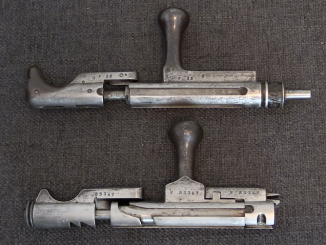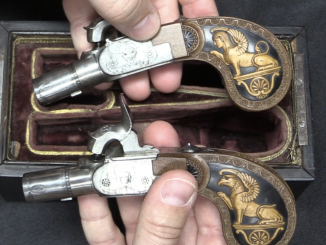For another perspective on the AA52 – and some live fire footage – check out Bloke on the Range’s video on the gun today:
With the end of World War Two, it was finally time for France to replace the Hotchkiss 1914 heavy machine gun with something more modern. The German universal machine gun concept had garnered a lot of attention with militaries worldwide, and the French opted to look for just such a design. They wanted something belt-fed that could serve in a light role off a bipod, a heavy role off a tripod, or a vehicular role. Three French design bureaus went to work, and the winner was the Chatellerault arsenal with the gun that would be adopted as the AA52 (Arme Automatique 1952).
The AA52 is a simple to construct weapon made largely from heavy-gage stampings. It is chambered for the 7.5x54mm French rifle cartridge (although it was rather quickly replaced by the AA-F1, a version in 7.62mm NATO) and uses a lever-delayed blowback action. Thus, it has no gas system, nor the complexity of a recoil operated design. It is a rugged and simple gun, but not particularly comfortable to shoot.
Many thanks to the French IRCGN (Criminal Research Institute of the National Gendarmerie) for generously giving me access to film this very cool specimen for you!




Kinematically, the mechanism is also essentially the same as the one used in the G3 rifle (although the G3 uses a pair of rollers rather than a single lever).
Similar, yes as both are mechanically delayed actions, but exactly how the powers exerted on the levers/rollers play against each other is different.
https://modernfirearms.net/en/machineguns/france-machineguns/aat-mod-52-eng/ claims this weapon a modified delayed blowback action originally designed by PalKiraly.
I suppose this grant similarity to Cristóbal Carbine
No argument from me there. And, just to clarify, I’m only saying that the AA52 and G3 mechanisms are _kinematically_ similar, in that they are both delayed blowback mechanisms, using a lightweight bolt head and a heavier bolt body or carrier, and some form of mechanical leverage between them, to delay opening of the bolt. The actual mechanics, bits and pieces are different.
Incidentally, the 1943/44 Mauser Gerät 06H (https://modernfirearms.net/en/assault-rifles/germany-assault-rifles/stg-45m-eng/) was apparently the first weapon to use the G3-type roller delay system. It could be that it was partly inspired by Pal Kiraky’s earlier work, although according to the linked page, the Mauser system evolved from a gas-operated, roller-locked system.
Kiralyi’s patent might have been in force then, but I wonder if the AA52 was in conflict with it or if license was purchased. Frankly I have a doubt.
Excerpt from article:
“It was not without certain flaws, however the most important being its retarded blowback action, which is sensitive to headspace adjustments and the timing of the bolt /retarder group.”
In my view this is not really a “fixed” headspace mechanism, but rather a “floating one”. It addition it has to be tied with firing pin protrusion (anchored in Carrier). From what I read in past is that another issue burdened AA52 and that was barrel droop during intensive firing. I suspect this gun saw a plenty of it during operations in SAHEL.
In any case, this is a clever French-like mechanical solution. Simply ingenious.
Already the FNAB-43 SMG was lever-delayed without links to Kiralyi.
The Kiraly patent (actually the U.S. version 1073908) was applied for in 1912 and therefore long expired at the time the AA52 was developed.
Are there any pictures or info available on the two other trial designs from St.Etienne and Mulhouse?
These are truely forgotten weapons. Ian filmed this at the Gendarmerie. I doubt they keep prototypes there. Is there a collection by the armee del terre? that might be more extensive.
“any(…)info available on the two other trial designs from St.Etienne and Mulhouse?”
https://www.smallarmsreview.com/display.article.cfm?idarticles=1346 has succinct description thereof
the Ateliers de Mulhouse that developed a weapon derived from the MG 42,
the Manufacture Nationale d’Armes de Saint-Etienne that developed a gas action machine gun(…)Each one of these weapons was envisioned to be fed by link, box magazines, or both. Additionally, each gun was developed in a light and heavy model for the French 7.5mm cartridge or American .30-06.
Therefore it can be suspected that Mulhouse one was recoil-operated. One has to wonder if Rate-of-Fire was altered or original keep.
Above linked article mention also An enlarged version of A.A. 52 in .50 caliber was studied between 1956 and 1959, but was not adopted., photo of said weapon can be seen here https://guns.fandom.com/wiki/MAC-58
H&K was developing a .50 Browning roller delayed machine gun as well, but dropped the development for being not really feasible. The bolt carrier would have had to be really heavy to work with the recoil of .50″. And the Bundeswehr in the sixties did away with its M2 machine guns except for a few ship mounted guns. They put MG3 on every vehicle or went one size up to the FK20 20 mm trailed machine cannon. So there was no primary customer left, too. Fench Army simply bought M2 machine guns from FN.
I note that Chappie says it is “extremely comfortable to shoot” https://youtu.be/ttE3vBZizbo?t=1943
Be warned that according to https://www.smallarmsreview.com/display.article.cfm?idarticles=1346 there existed various supports: bipod with tubular legs, bipod with U-shaped sheet metal legs, U.S. M2 tripod with special mounting MF 52 (Modified French 1952) for the heavy version. It is fitted with an elastic recoil device. and 2 different cartridge version (7,5 mm and 7,62 mm), which if all possible combination existed gives 6 configurations, with each might feel different.
Interesting that it uses disintegrating or continuous link belts. We’re they joined belts assembled in sections like the RPD? Quite a high rate of fire.
From Chappie’s video, I believe issue belts were 50 round disintegrating link. The continuous link belts in the video are MG42 belts that happen to work with 7.5mm French ammo and the AA52 action.
Are there the Revellis grooves in the chamber? How they solved the friction during extraction if the system is not fully locked?
https://modernfirearms.net/en/machineguns/france-machineguns/aat-mod-52-eng/
…the gun has a fluted chamber…
cool looking, too. nice.
I enjoyed firing it when I was in the military there.
As well as all the weapons we had.
I too find French weapons to be interesting. The have a habit of being that bit different.
I also find the Kiraly lever locking system interesting. Every time I see it demonstrated I understand it, then I immediately forget, and have to watch again.
I noticed from watching the firing video that there is often quite a big flash from the breech end of the gun. Clearly, the bolt is opening just a little bit too early, which is what I would expect. Also, delayed blowback looks like a good way of making the gun as dirty as humanly possible.
Some of the machining on the gun make it look like a product of a home workshop. Clearly the French were going for something which was as cheap as possible. But seeing they were busy with expensive wars in Indo-China and Algeria, perhaps that is to be expected. I a very happy to see these videos, which shed light on a gun I have always found interesting. Merci beaucoup.
“(…)quite a big flash from the breech end of the gun. Clearly, the bolt is opening just a little bit too early, which is what I would expect. Also, delayed blowback looks like a good way of making the gun as dirty as humanly possible.(…)”
According to https://modernfirearms.net/en/machineguns/france-machineguns/aat-mod-52-eng/
While this locking system is relatively simple, it is quite sensitive to head spacing and also permits a lot of fouling, created by burning powder, to get inside there ceiver.
Daweo,
As you say. Did the French use steel cases in the AA52?
I wonder if there were ever any plans to replace the Hotchkiss before WWII? I suppose the French were busy with new pistols, rifles and a new LMG, but they must have realised the Hotchkiss needed to be replaced eventually. However, it was very simple and reliable, and did not mind using 8mm Lebel, so perhaps that was a project they thought they could safely delay.
“(…)any plans to replace the Hotchkiss before WWII?(…)”
Hotchkiss was partially replaced by Reibel https://guns.fandom.com/wiki/Reibel_machine_gun in tank machine gun role.
French also entertained concept of cartridge bigger than their 7,5 mm and smaller than their 13,2 mm. It is today known as 9 X 66 FRENCH MAS XPL
http://cartridgecollector.net/9-x-66-french-mas-xpl
they did not manage to push into service before Fall Gelb.
Photo of weapon and complete cartridge (1st from bottom) can be seen here
http://airwar.ru/weapon/guns/mle1938.html
Any delay mechanism that exchange the mass of the bolt with its speed (roller, lever, radial…) seems to live on a delicate balance between mass of the bolt, lenght of the lever (slope of the inclined surfaces) and charateristics of the ammo. The less delay is needed (so the heavier the bolt or the lower pressure the ammo) the better. The more delay is needed, the more difficult is to find the right spot between too little delay (flash from the breech, fouling, need for sturdier cases than standard) and too much of it (doesn’t cycle reliably).